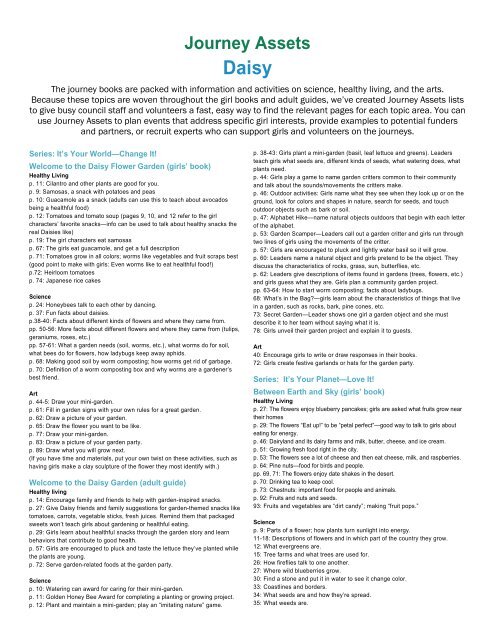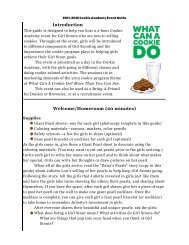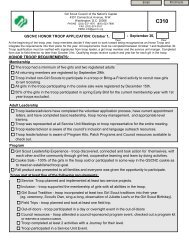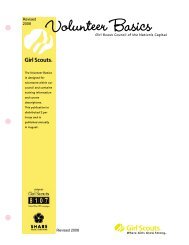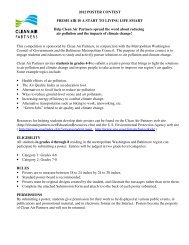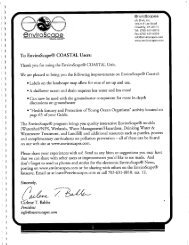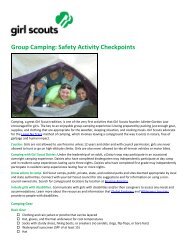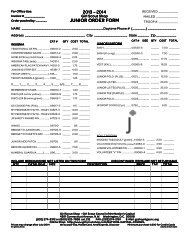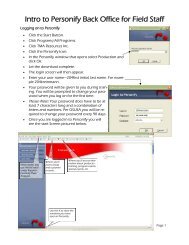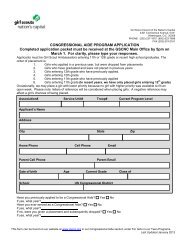Daisy Journey Assets (PDF) - Girl Scouts of the USA
Daisy Journey Assets (PDF) - Girl Scouts of the USA
Daisy Journey Assets (PDF) - Girl Scouts of the USA
You also want an ePaper? Increase the reach of your titles
YUMPU automatically turns print PDFs into web optimized ePapers that Google loves.
<strong>Journey</strong> <strong>Assets</strong><br />
<strong>Daisy</strong><br />
The journey books are packed with information and activities on science, healthy living, and <strong>the</strong> arts.<br />
Because <strong>the</strong>se topics are woven throughout <strong>the</strong> girl books and adult guides, we’ve created <strong>Journey</strong> <strong>Assets</strong> lists<br />
to give busy council staff and volunteers a fast, easy way to find <strong>the</strong> relevant pages for each topic area. You can<br />
use <strong>Journey</strong> <strong>Assets</strong> to plan events that address specific girl interests, provide examples to potential funders<br />
and partners, or recruit experts who can support girls and volunteers on <strong>the</strong> journeys.<br />
Series: It’s Your World—Change It!<br />
Welcome to <strong>the</strong> <strong>Daisy</strong> Flower Garden (girls’ book)<br />
Healthy Living<br />
p. 11: Cilantro and o<strong>the</strong>r plants are good for you.<br />
p. 9: Samosas, a snack with potatoes and peas<br />
p. 10: Guacamole as a snack (adults can use this to teach about avocados<br />
being a healthful food)<br />
p. 12: Tomatoes and tomato soup (pages 9, 10, and 12 refer to <strong>the</strong> girl<br />
characters’ favorite snacks—info can be used to talk about healthy snacks <strong>the</strong><br />
real Daisies like)<br />
p. 19: The girl characters eat samosas<br />
p. 67: The girls eat guacamole, and get a full description<br />
p. 71: Tomatoes grow in all colors; worms like vegetables and fruit scraps best<br />
(good point to make with girls: Even worms like to eat healthful food!)<br />
p.72: Heirloom tomatoes<br />
p. 74: Japanese rice cakes<br />
Science<br />
p. 24: Honeybees talk to each o<strong>the</strong>r by dancing.<br />
p. 37: Fun facts about daisies.<br />
p.38-40: Facts about different kinds <strong>of</strong> flowers and where <strong>the</strong>y came from.<br />
pp. 50-56: More facts about different flowers and where <strong>the</strong>y came from (tulips,<br />
geraniums, roses, etc.)<br />
pp. 57-61: What a garden needs (soil, worms, etc.), what worms do for soil,<br />
what bees do for flowers, how ladybugs keep away aphids.<br />
p. 68: Making good soil by worm composting; how worms get rid <strong>of</strong> garbage.<br />
p. 70: Definition <strong>of</strong> a worm composting box and why worms are a gardener’s<br />
best friend.<br />
Art<br />
p. 44-5: Draw your mini-garden.<br />
p. 61: Fill in garden signs with your own rules for a great garden.<br />
p. 62: Draw a picture <strong>of</strong> your garden.<br />
p. 65: Draw <strong>the</strong> flower you want to be like.<br />
p. 77: Draw your mini-garden.<br />
p. 83: Draw a picture <strong>of</strong> your garden party.<br />
p. 89: Draw what you will grow next.<br />
(If you have time and materials, put your own twist on <strong>the</strong>se activities, such as<br />
having girls make a clay sculpture <strong>of</strong> <strong>the</strong> flower <strong>the</strong>y most identify with.)<br />
Welcome to <strong>the</strong> <strong>Daisy</strong> Garden (adult guide)<br />
Healthy living<br />
p. 14: Encourage family and friends to help with garden-inspired snacks.<br />
p. 27: Give <strong>Daisy</strong> friends and family suggestions for garden-<strong>the</strong>med snacks like<br />
tomatoes, carrots, vegetable sticks, fresh juices. Remind <strong>the</strong>m that packaged<br />
sweets won’t teach girls about gardening or healthful eating.<br />
p. 29: <strong>Girl</strong>s learn about healthful snacks through <strong>the</strong> garden story and learn<br />
behaviors that contribute to good health.<br />
p. 57: <strong>Girl</strong>s are encouraged to pluck and taste <strong>the</strong> lettuce <strong>the</strong>y’ve planted while<br />
<strong>the</strong> plants are young.<br />
p. 72: Serve garden-related foods at <strong>the</strong> garden party.<br />
Science<br />
p. 10: Watering can award for caring for <strong>the</strong>ir mini-garden.<br />
p. 11: Golden Honey Bee Award for completing a planting or growing project.<br />
p. 12: Plant and maintain a mini-garden; play an “imitating nature” game.<br />
p. 38-43: <strong>Girl</strong>s plant a mini-garden (basil, leaf lettuce and greens). Leaders<br />
teach girls what seeds are, different kinds <strong>of</strong> seeds, what watering does, what<br />
plants need.<br />
p. 44: <strong>Girl</strong>s play a game to name garden critters common to <strong>the</strong>ir community<br />
and talk about <strong>the</strong> sounds/movements <strong>the</strong> critters make.<br />
p. 46: Outdoor activities: <strong>Girl</strong>s name what <strong>the</strong>y see when <strong>the</strong>y look up or on <strong>the</strong><br />
ground, look for colors and shapes in nature, search for seeds, and touch<br />
outdoor objects such as bark or soil.<br />
p. 47: Alphabet Hike—name natural objects outdoors that begin with each letter<br />
<strong>of</strong> <strong>the</strong> alphabet.<br />
p. 53: Garden Scamper—Leaders call out a garden critter and girls run through<br />
two lines <strong>of</strong> girls using <strong>the</strong> movements <strong>of</strong> <strong>the</strong> critter.<br />
p. 57: <strong>Girl</strong>s are encouraged to pluck and lightly water basil so it will grow.<br />
p. 60: Leaders name a natural object and girls pretend to be <strong>the</strong> object. They<br />
discuss <strong>the</strong> characteristics <strong>of</strong> rocks, grass, sun, butterflies, etc.<br />
p. 62: Leaders give descriptions <strong>of</strong> items found in gardens (trees, flowers, etc.)<br />
and girls guess what <strong>the</strong>y are. <strong>Girl</strong>s plan a community garden project.<br />
pp. 63-64: How to start worm composting; facts about ladybugs.<br />
68: What’s in <strong>the</strong> Bag?—girls learn about <strong>the</strong> characteristics <strong>of</strong> things that live<br />
in a garden, such as rocks, bark, pine cones, etc.<br />
73: Secret Garden—Leader shows one girl a garden object and she must<br />
describe it to her team without saying what it is.<br />
78: <strong>Girl</strong>s unveil <strong>the</strong>ir garden project and explain it to guests.<br />
Art<br />
40: Encourage girls to write or draw responses in <strong>the</strong>ir books.<br />
72: <strong>Girl</strong>s create festive garlands or hats for <strong>the</strong> garden party.<br />
Series: It’s Your Planet—Love It!<br />
Between Earth and Sky (girls’ book)<br />
Healthy Living<br />
p. 27: The flowers enjoy blueberry pancakes; girls are asked what fruits grow near<br />
<strong>the</strong>ir homes<br />
p. 29: The flowers “Eat up!” to be “petal perfect”—good way to talk to girls about<br />
eating for energy.<br />
p. 46: Dairyland and its dairy farms and milk, butter, cheese, and ice cream.<br />
p. 51: Growing fresh food right in <strong>the</strong> city.<br />
p. 53: The flowers see a lot <strong>of</strong> cheese and <strong>the</strong>n eat cheese, milk, and raspberries.<br />
p. 64: Pine nuts—food for birds and people.<br />
pp. 69, 71: The flowers enjoy date shakes in <strong>the</strong> desert.<br />
p. 70: Drinking tea to keep cool.<br />
p. 73: Chestnuts: important food for people and animals.<br />
p. 92: Fruits and nuts and seeds.<br />
93: Fruits and vegetables are “dirt candy”; making “fruit pops.”<br />
Science<br />
p. 9: Parts <strong>of</strong> a flower; how plants turn sunlight into energy.<br />
11-18: Descriptions <strong>of</strong> flowers and in which part <strong>of</strong> <strong>the</strong> country <strong>the</strong>y grow.<br />
12: What evergreens are.<br />
15: Tree farms and what trees are used for.<br />
26: How fireflies talk to one ano<strong>the</strong>r.<br />
27: Where wild blueberries grow.<br />
30: Find a stone and put it in water to see it change color.<br />
33: Coastlines and borders.<br />
34: What seeds are and how <strong>the</strong>y’re spread.<br />
35: What weeds are.
36. Habitats: Clearing out vincas and planting plants that salamanders eat.<br />
37: Making seed birds to restore vegetation.<br />
40-41: Fireflies and where <strong>the</strong>y live (none west <strong>of</strong> <strong>the</strong> Rockies).<br />
42: How sunflowers clean <strong>the</strong> soil.<br />
46: What’s made from milk; why taking care <strong>of</strong> <strong>the</strong> soil is important.<br />
50: How bicycles are energy-smart.<br />
51: Growing food in <strong>the</strong> city.<br />
56: Birds migrating past <strong>the</strong> Great Salt Lake.<br />
57: Facts about <strong>the</strong> Great Salt Lake.<br />
60-61: Why it’s easy to float in <strong>the</strong> Great Salt Lake.<br />
61: <strong>Girl</strong>s experiment by adding salt to a cup <strong>of</strong> water to see how many things<br />
will float.<br />
62-5: Pinon pine nuts as food for birds; using resources wisely.<br />
65: The Ips beetle, fungus, and saving pinon pine trees.<br />
67-69: What a desert habitat is like; facts about tumbleweeds.<br />
70: Why hot tea makes you feel cooler on a hot day.<br />
73: The chestnut fungus and how chestnut trees are making a comeback.<br />
75: The climate <strong>of</strong> nor<strong>the</strong>rn and sou<strong>the</strong>rn California.<br />
79: The habitat at Half Moon Bay in California.<br />
80-81: Facts about redwoods and ladybugs.<br />
82: Facts about habitats and why plants in <strong>the</strong> wrong place can crowd out o<strong>the</strong>r<br />
important plants.<br />
83-84: Why <strong>the</strong>re are fewer salmon in <strong>the</strong> Klamath River and why <strong>the</strong>y should<br />
be protected.<br />
86-91: How white sweetclover is damaging <strong>the</strong> environment in Alaska and what<br />
people are doing to help.<br />
92: Where seeds are (cones, nuts, etc.)<br />
Art<br />
15: Draw <strong>the</strong> trees that grow where you live.<br />
22: Draw how you feel when you’ve kept a promise.<br />
36: Draw plants you see that are growing where <strong>the</strong>y shouldn’t.<br />
58-59: The Spiral Jetty as earth art; making art that helps earth; draw a picture<br />
<strong>of</strong> your earth art.<br />
96: Draw your favorite leaves, seeds, petals.<br />
(If you have time and materials, put your own twist on <strong>the</strong>se activities, such as<br />
having girls make a mural <strong>of</strong> <strong>the</strong> trees that grow where <strong>the</strong>y live or a Play-Doh<br />
sculpture <strong>of</strong> <strong>the</strong>ir earth art.)<br />
<strong>the</strong>m; outdoor time to look at seeds in nature.<br />
70: <strong>Girl</strong>s experiment with an array <strong>of</strong> stones and bowls <strong>of</strong> water and describe<br />
how stones change when wet.<br />
71: A walk in nature to find shapes; experiment with a compass to figure out<br />
location and directions.<br />
72: Share photos <strong>of</strong> soil- and air-cleaning plants<br />
75: How sunflowers clean soil; take a trip to see sunflowers in action.<br />
79: Why milk and cheese make you sleepy.<br />
80: Nature walk to find textures, making a list <strong>of</strong> all <strong>the</strong> textures you find.<br />
82: Clover project: teach girls to protect Earth’s resources by protecting a local<br />
treasure—clean up a lot, add local plants to urban spaces, spread <strong>the</strong> word<br />
about a local bird that needs protecting, etc.<br />
84: Walk in nature to rub a tree.<br />
85: <strong>Girl</strong>s learn about different trees and which ones grow in <strong>the</strong>ir area and<br />
make bark rubbings.<br />
88: <strong>Girl</strong>s learn about using resources wisely to protect a local treasure.<br />
89: Invasive plants and <strong>the</strong>ir effect on <strong>the</strong> environment.<br />
Art<br />
36: Introduce <strong>the</strong> artist who created <strong>the</strong> cut-paper images in Between Earth and<br />
Sky; prepare to create a cut-paper poster.<br />
42: Make luggage tags/bookmarks.<br />
47: Draw <strong>the</strong> item you’ve collected.<br />
50-51: <strong>Girl</strong>s make a team journey poster from cut paper.<br />
52: Suggest girls dream up <strong>the</strong>ir own cars and make drawings.<br />
53: Draw a square <strong>of</strong> your favorite color; show girls examples <strong>of</strong> exotic colors.<br />
56: Draw a picture <strong>of</strong> what different feelings look like.<br />
62: Decorate luggage tags/bookmarks; make origami butterflies.<br />
66: How to make an origami butterfly.<br />
71: Draw a favorite shape and try to find it outdoors.<br />
72: Create a firefly suitcase; continue to work on journey poster.<br />
76: Make natural “paints” out <strong>of</strong> vegetables.<br />
81: <strong>Girl</strong>s draw textures <strong>the</strong>y find in nature.<br />
82: Make posters to encourage people to mind seeds and weeds; make a<br />
booklet, play or o<strong>the</strong>r creative endeavor to <strong>of</strong>fer tips for protecting local<br />
vegetation.<br />
86: Walk in nature to make bark rubbings.<br />
94: Draw a picture <strong>of</strong> how your partner used a special skill.<br />
<strong>Daisy</strong>: Between Earth and Sky (adult guide)<br />
Healthy Living<br />
17: Encourage family and friends to provide earthy treats, like vegetables and<br />
fruits, and locally produced foods, such as cheeses and breads.<br />
58: Snack time feast <strong>of</strong> plant parts: flowers (broccoli), stems (celery), leaves<br />
(lettuce), etc.<br />
76-79: Snack on local foods.<br />
95: Celebrate with an array <strong>of</strong> healthful snacks in all shapes and colors,<br />
perhaps cutting fruit and cheese into shapes with cookie cutters.<br />
Science<br />
7: Lupe’s petal-powered car can inspired budding engineers and designers;<br />
travel <strong>the</strong>me can introduce using a compass and map-reading skills. Introduces<br />
girls to exploring <strong>the</strong> wonders <strong>of</strong> nature, diverse terrain, oceans, mountains,<br />
deserts, etc. Women introduced in <strong>the</strong> stories work to protect and nurture <strong>the</strong><br />
environment (ecologists, biologists, etc.)<br />
15: <strong>Girl</strong>s earn <strong>the</strong> Clover Award by teaming up to protect a natural treasure in<br />
<strong>the</strong>ir region.<br />
20: Teaching girls about not disturbing nature, Leave No Trace.<br />
39: Explanation <strong>of</strong> how science is built into every session.<br />
41: Leaders are encouraged to make time for field trips to study nature.<br />
46: <strong>Girl</strong>s take a nature walk, collect a natural item and classify it. Collecting,<br />
observing and classifying are basic science skills.<br />
52: Suggest girls dream up <strong>the</strong>ir own cars and draw <strong>the</strong>m, or ga<strong>the</strong>r items that<br />
girls use to build some miniature cars.<br />
53: Bring a variety <strong>of</strong> soils for girls to touch and smell; explain what different<br />
types <strong>of</strong> soil are like.<br />
54: Suggest girls find different colors in nature during <strong>the</strong>ir walk.<br />
58: Show girls a droopy plant and let <strong>the</strong>m water it; explain how plants drink;<br />
explain how <strong>the</strong> foods we eat are plant parts.<br />
62: How fireflies produce light.<br />
65: Have a local farmer show girls a variety <strong>of</strong> seed; show how wind can blow


